SUBARU TRIBECA 2014 1.G Manual PDF
Manufacturer: SUBARU, Model Year: 2014, Model line: TRIBECA, Model: SUBARU TRIBECA 2014 1.GPages: 426, PDF Size: 6.37 MB
Page 71 of 426
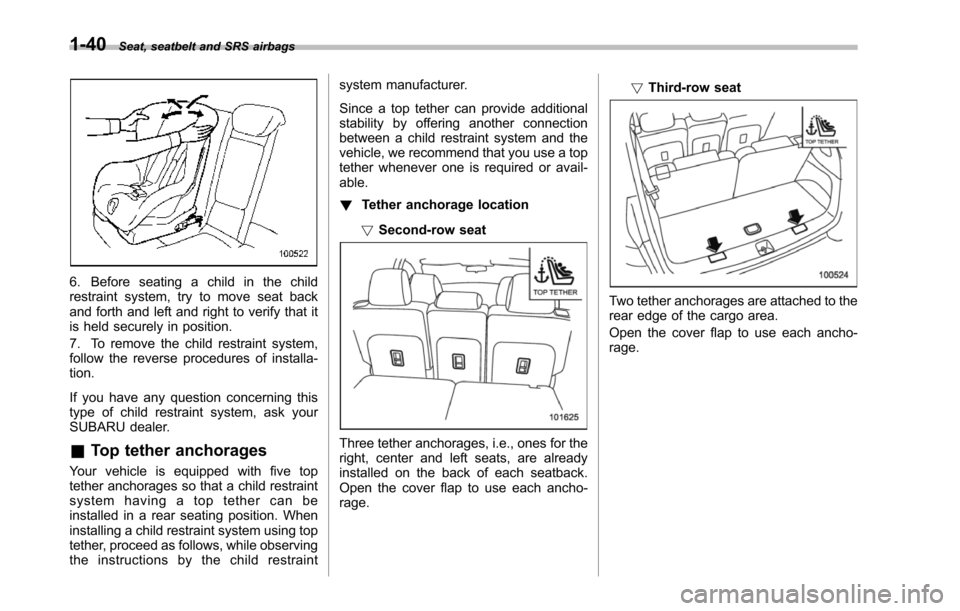
1-40Seat, seatbelt and SRS airbags
6. Before seating a child in the childrestraint system, try to move seat backand forth and left and right to verify that itis held securely in position.
7. To remove the child restraint system,follow the reverse procedures of installa-tion.
If you have any question concerning thistype of child restraint system, ask yourSUBARU dealer.
&Top tether anchorages
Your vehicle is equipped with five toptether anchorages so that a child restraintsystem having a top tether can beinstalled in a rear seating position. Wheninstalling a child restraint system using toptether, proceed as follows, while observingthe instructions by the child restraint
system manufacturer.
Since a top tether can provide additionalstability by offering another connectionbetween a child restraint system and thevehicle, we recommend that you use a toptether whenever one is required or avail-able.
!Tether anchorage location
!Second-row seat
Three tether anchorages, i.e., ones for theright, centerand left seats, are alreadyinstalled on the back of each seatback.Open the cover flap to use each ancho-rage.
!Third-row seat
Two tether anchorages are attached to therear edge of the cargo area.
Open the cover flap to use each ancho-rage.
Page 72 of 426
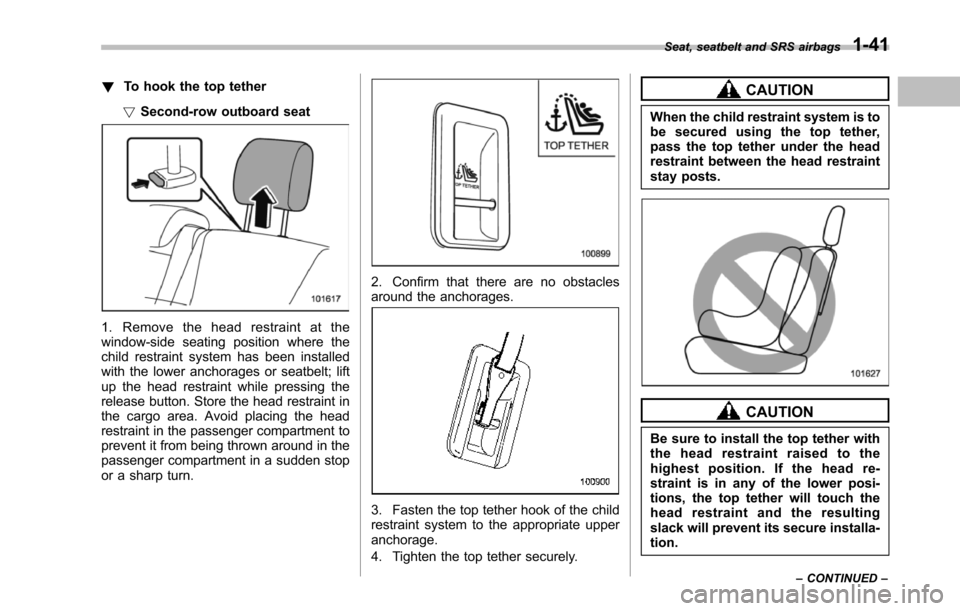
!To hook the top tether
!Second-row outboard seat
1. Remove the head restraint at thewindow-sideseating position where thechild restraint system has been installedwith the lower anchorages or seatbelt; liftup the head restraint while pressing therelease button. Store the head restraint inthe cargo area. Avoid placing the headrestraint in the passenger compartment toprevent it from being thrown around in thepassenger compartment in a sudden stopor a sharp turn.
2. Confirm that there are no obstaclesaround the anchorages.
3. Fasten the top tether hook of the childrestraint system to the appropriate upperanchorage.
4. Tighten the top tether securely.
CAUTION
When the child restraint system is tobe secured using the top tether,pass the top tether under the headrestraint between the head restraintstay posts.
CAUTION
Be sure to install the top tether withthe head restraint raised to thehighest position. If the head re-straint is in any of the lower posi-tions, the top tether will touch thehead restraint and the resultingslack will prevent its secure installa-tion.
Seat, seatbelt and SRS airbags1-41
–CONTINUED–
Page 73 of 426
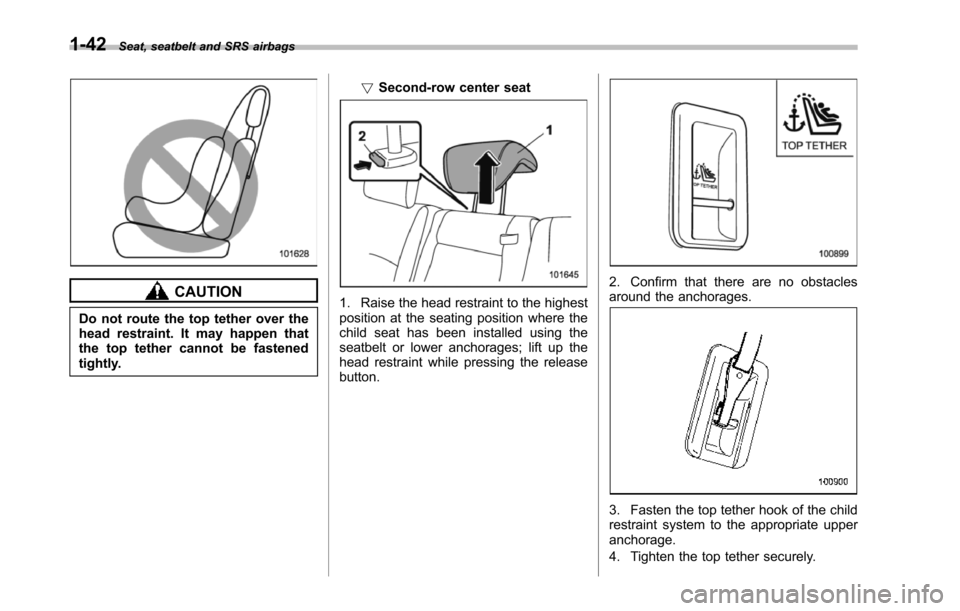
1-42Seat, seatbelt and SRS airbags
CAUTION
Do not route the top tether over thehead restraint. It may happen thatthe top tether cannot be fastenedtightly.
!Second-row center seat
1. Raise the head restraint to the highestposition at the seating position where thechild seat has been installed using theseatbelt or lower anchorages; lift up thehead restraint while pressing the releasebutton.
2. Confirm that there are no obstaclesaround the anchorages.
3. Fasten the top tether hook of the childrestraintsystem to the appropriate upperanchorage.
4. Tighten the top tether securely.
Page 74 of 426
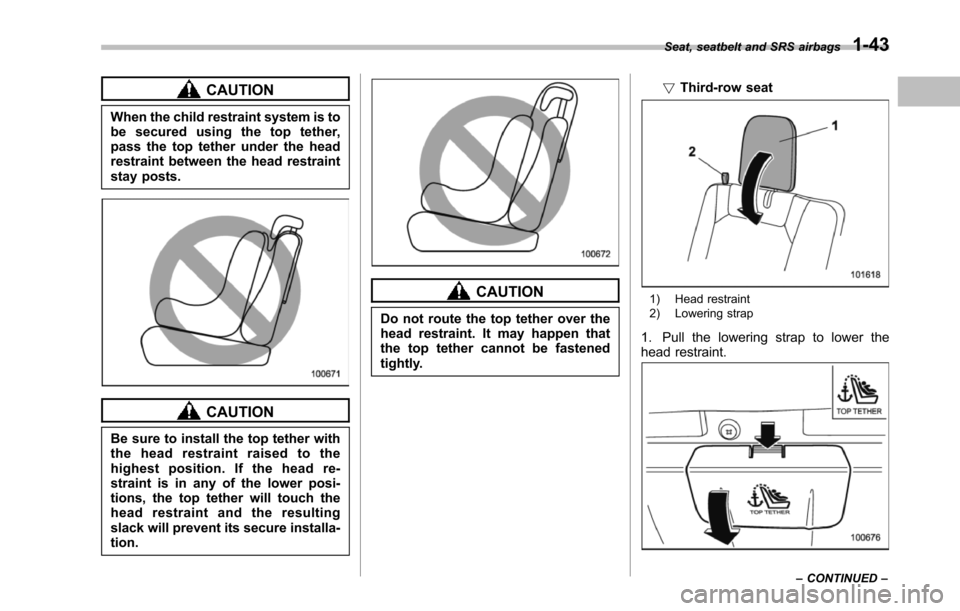
CAUTION
When the child restraint system is tobe secured using the top tether,pass the top tether under the headrestraint between the head restraintstay posts.
CAUTION
Be sure to install the top tether withthe head restraint raised to thehighest position. If the head re-straint is in any of the lower posi-tions, the top tether will touch thehead restraint and the resultingslack will prevent its secure installa-tion.
CAUTION
Do not route the top tether over thehead restraint. It may happen thatthe top tether cannot be fastenedtightly.
!Third-row seat
1) Head restraint2) Lowering strap
1. Pull the lowering strap to lower thehead restraint.
Seat, seatbelt and SRS airbags1-43
–CONTINUED–
Page 75 of 426
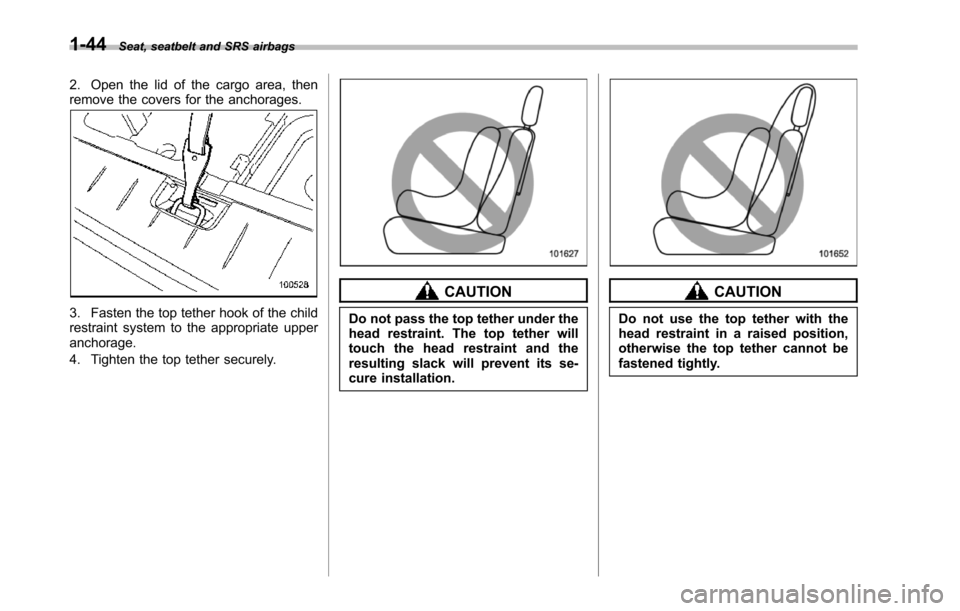
1-44Seat, seatbelt and SRS airbags
2. Open the lid of the cargo area, thenremove the covers for the anchorages.
3. Fasten the top tether hook of the childrestraint systemto the appropriate upperanchorage.
4. Tighten the top tether securely.
CAUTION
Do not pass the top tether under thehead restraint. The top tether willtouch the head restraint and theresulting slack will prevent its se-cure installation.
CAUTION
Do not use the top tether with thehead restraint in a raised position,otherwise the top tether cannot befastened tightly.
Page 76 of 426
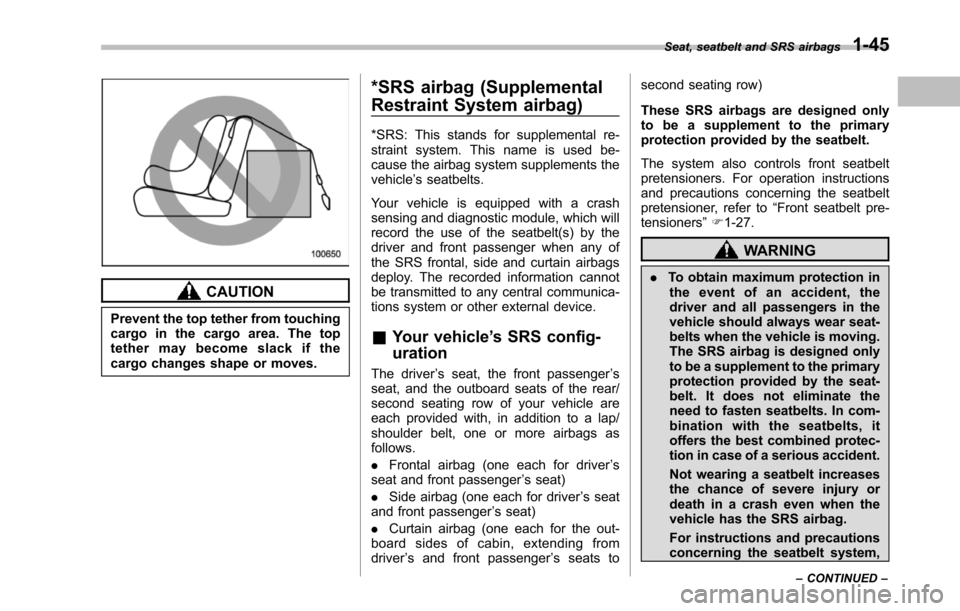
CAUTION
Prevent the top tether from touchingcargo in the cargo area. The toptether may become slack if thecargo changes shape or moves.
*SRS airbag (Supplemental
Restraint System airbag)
*SRS: This stands for supplemental re-straint system. This name is used be-cause the airbag system supplements thevehicle’s seatbelts.
Your vehicle is equipped with a crashsensing and diagnostic module, which willrecord the use of the seatbelt(s) by thedriver and front passenger when any oftheSRS frontal, side and curtain airbagsdeploy. The recorded information cannotbe transmitted to any central communica-tions system or other external device.
&Your vehicle’s SRS config-
uration
The driver’s seat, the front passenger’sseat, and the outboard seats of the rear/second seating row of your vehicle areeach provided with, in addition to a lap/shoulder belt, one or more airbags asfollows.
.Frontal airbag (one each for driver’sseat and front passenger’s seat)
.Side airbag (one each for driver’s seatand front passenger’s seat)
.Curtain airbag (one each for the out-board sides of cabin, extending fromdriver’s and front passenger’s seats to
second seating row)
These SRS airbags are designed onlyto be a supplement to the primaryprotection provided by the seatbelt.
The system also controls front seatbeltpretensioners. For operation instructionsand precautions concerning the seatbeltpretensioner, refer to“Frontseatbelt pre-tensioners”F1-27.
WARNING
.To obtain maximum protection inthe event of an accident, thedriverand all passengers in thevehicle should always wear seat-belts when the vehicle is moving.The SRS airbag is designed onlyto be a supplement to the primaryprotection provided by the seat-belt. It does not eliminate theneed to fasten seatbelts. In com-bination with the seatbelts, itoffers the best combined protec-tion in case of a serious accident.
Not wearing a seatbelt increasesthe chance of severe injury ordeath in a crash even when thevehicle has the SRS airbag.
For instructions and precautionsconcerning the seatbelt system,
Seat, seatbelt and SRS airbags1-45
–CONTINUED–
Page 77 of 426
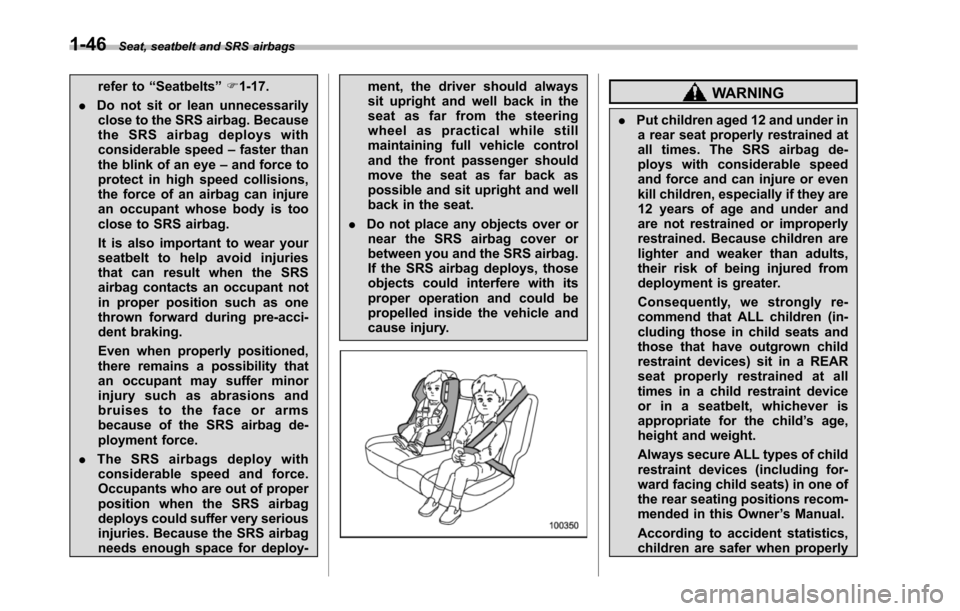
1-46Seat, seatbelt and SRS airbags
refer to“Seatbelts”F1-17.
.Do not sit or lean unnecessarilyclose to the SRS airbag. Becausethe SRS airbag deploys withconsiderable speed–faster thanthe blink of an eye–and force toprotect in high speed collisions,the force of an airbag can injurean occupant whose body is tooclose to SRS airbag.
It is also important to wear yourseatbelt to help avoid injuriesthat can result when the SRSairbag contacts an occupant notin proper position such as onethrown forward during pre-acci-dent braking.
Even when properly positioned,there remainsa possibility thatan occupant may suffer minorinjury such as abrasions andbruises to the face or armsbecause of the SRS airbag de-ployment force.
.The SRS airbags deploy withconsiderable speed and force.Occupants who are out of properposition when the SRS airbagdeploys could suffer very seriousinjuries. Because the SRS airbagneeds enough space for deploy-
ment, the driver should alwayssit upright and well back in theseat as far from the steeringwheel as practical while stillmaintaining full vehicle controland the front passenger shouldmove the seat as far back aspossible and sit upright and wellback in the seat.
.Do not place any objects over ornear the SRS airbag cover orbetween you and the SRS airbag.If the SRS airbag deploys, thoseobjects could interfere with itsproper operation and could bepropelled inside the vehicle andcause injury.
WARNING
.Put children aged 12 and under ina rear seat properly restrained atall times. The SRS airbag de-ploys with considerable speedand force and can injure or evenkill children, especially if they are12 years of age and under andare not restrained or improperlyrestrained. Because children arelighter and weaker than adults,their risk of being injured fromdeployment is greater.
Consequently, we strongly re-commend that ALL children (in-cluding those in child seats andthose that have outgrown childrestraintdevices) sit in a REARseat properly restrained at alltimes in a child restraint deviceor in a seatbelt, whichever isappropriate for the child’s age,height and weight.
Always secure ALL types of childrestraint devices (including for-ward facing child seats) in one ofthe rear seating positions recom-mended in this Owner’s Manual.
According to accident statistics,children are safer when properly
Page 78 of 426
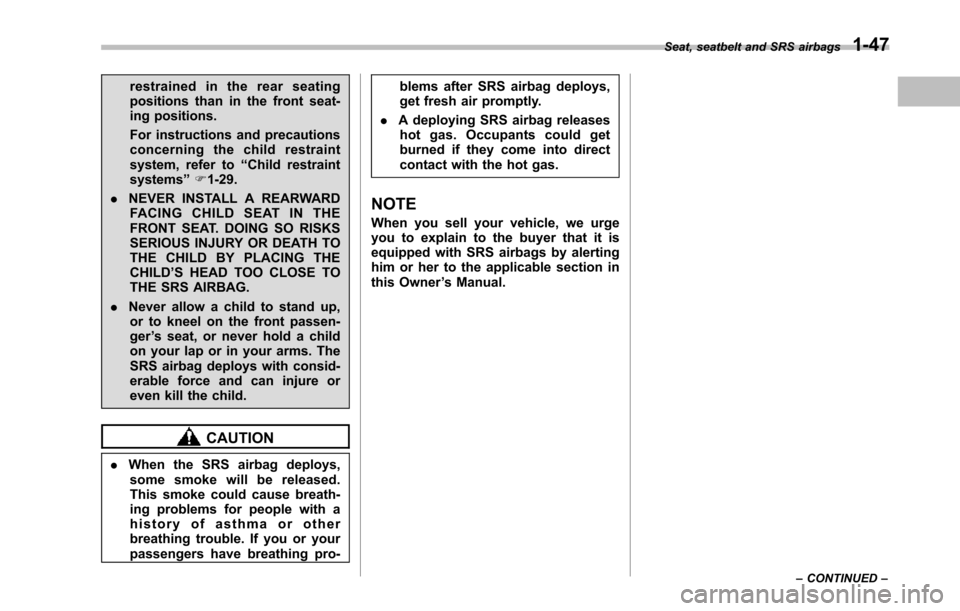
restrained in the rear seatingpositions than in the front seat-ing positions.
For instructions and precautionsconcerning the child restraintsystem, refer to“Child restraintsystems”F1-29.
.NEVER INSTALL A REARWARDFACING CHILD SEAT IN THEFRONTSEAT. DOING SO RISKSSERIOUS INJURY OR DEATH TOTHE CHILD BY PLACING THECHILD’S HEAD TOO CLOSE TOTHE SRS AIRBAG.
.Neverallow a child to stand up,or to kneel on the front passen-ger’s seat, or never hold a childon your lap or in your arms. TheSRS airbag deploys with consid-erableforce and can injure oreven kill the child.
CAUTION
.When the SRS airbag deploys,some smoke will be released.This smoke could cause breath-ing problems for people with ahistory of asthma or otherbreathing trouble. If you or yourpassengers have breathing pro-
blems after SRS airbag deploys,get fresh air promptly.
.A deploying SRS airbag releaseshot gas. Occupants could getburned if they come into directcontact with the hot gas.
NOTE
When you sell your vehicle, we urgeyou to explain to the buyer that it isequipped with SRS airbags by alertinghim or her to the applicable section inthis Owner’s Manual.
Seat, seatbelt and SRS airbags1-47
–CONTINUED–
Page 79 of 426
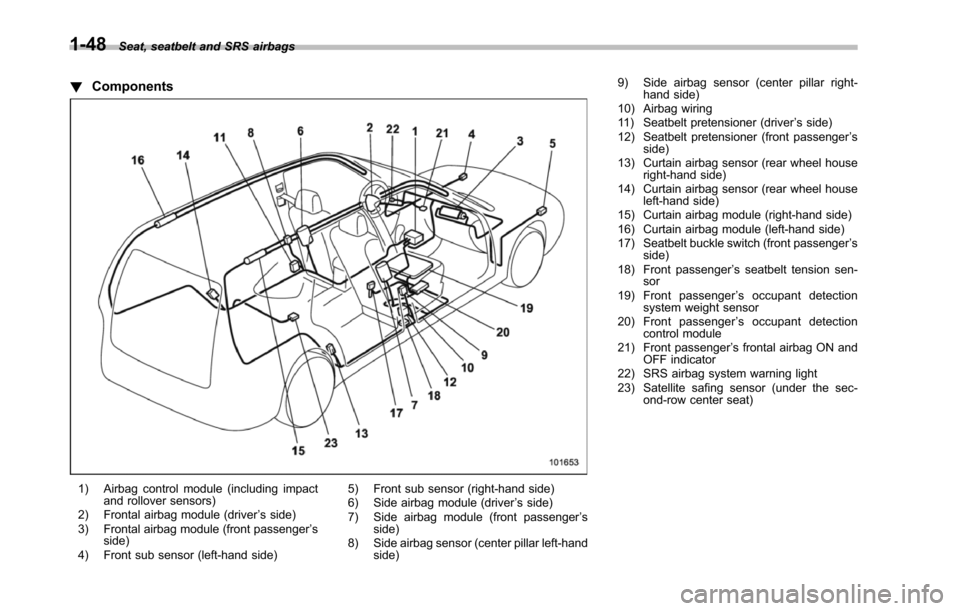
1-48Seat, seatbelt and SRS airbags
!Components
1) Airbag control module (including impactand rollover sensors)2) Frontal airbag module (driver’s side)3) Frontal airbag module (front passenger’sside)4) Front sub sensor (left-hand side)
5) Front sub sensor (right-hand side)6) Side airbag module (driver’s side)7) Side airbag module (front passenger’sside)8) Side airbag sensor (center pillar left-handside)
9) Side airbag sensor (center pillar right-hand side)10) Airbag wiring11) Seatbelt pretensioner (driver’s side)12) Seatbelt pretensioner (front passenger’sside)13) Curtain airbag sensor (rear wheel houseright-hand side)14) Curtain airbag sensor (rear wheel houseleft-hand side)15) Curtain airbag module (right-hand side)16) Curtain airbag module (left-hand side)17) Seatbelt buckle switch (front passenger’sside)18) Front passenger’s seatbelt tension sen-sor19) Front passenger’s occupant detectionsystem weight sensor20) Front passenger’s occupant detectioncontrol module21) Front passenger’s frontal airbag ON andOFF indicator22) SRS airbag system warning light23) Satellite safing sensor (under the sec-ond-row center seat)
Page 80 of 426
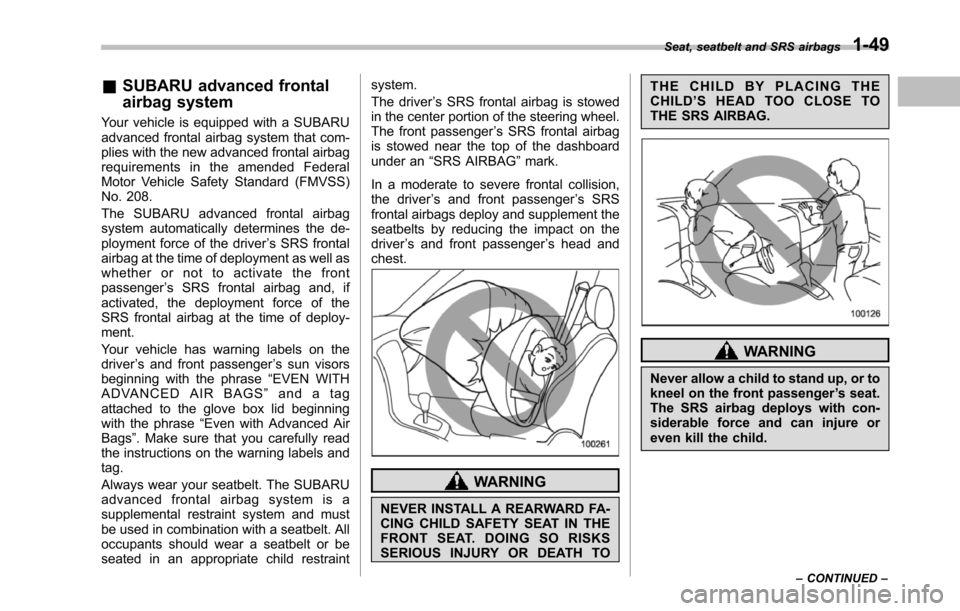
&SUBARU advanced frontal
airbag system
Your vehicle is equipped with a SUBARUadvanced frontal airbag system that com-plies with the new advanced frontal airbagrequirements in the amended FederalMotor Vehicle Safety Standard (FMVSS)No. 208.
The SUBARU advanced frontal airbagsystem automatically determines the de-ployment force of the driver’s SRS frontalairbag at the time of deployment as well aswhether or not to activate the frontpassenger’s SRS frontal airbag and, ifactivated, the deployment force of theSRS frontal airbag at the time of deploy-ment.
Your vehicle has warning labels on thedriver’s and front passenger’s sun visorsbeginning withthe phrase“EVENWITHADVANCED AIR BAGS”and a tagattached to the glove box lid beginningwiththe phrase“Evenwith Advanced AirBags”. Make sure that you carefully readthe instructions on the warning labels andtag.
Always wearyour seatbelt. The SUBARUadvanced frontal airbag system is asupplemental restraint system and mustbe used in combination with a seatbelt. Alloccupants should wear a seatbelt or beseated in an appropriate child restraint
system.
The driver’s SRS frontal airbag is stowedin the center portion of the steering wheel.The front passenger’s SRS frontal airbagis stowed near the top of the dashboardunder an“SRS AIRBAG”mark.
In a moderate to severe frontal collision,the driver’s and front passenger’s SRSfrontal airbagsdeploy and supplement theseatbelts by reducing the impact on thedriver’s and front passenger’s head andchest.
WARNING
NEVER INSTALL A REARWARD FA-CING CHILD SAFETY SEAT IN THEFRONT SEAT. DOING SO RISKSSERIOUS INJURY OR DEATH TO
THE CHILD BY PLACING THECHILD’SHEADTOOCLOSETOTHE SRS AIRBAG.
WARNING
Never allow a child to stand up, or tokneel on the front passenger’s seat.The SRS airbag deploys with con-siderable force and can injure oreven kill the child.
Seat, seatbelt and SRS airbags1-49
–CONTINUED–